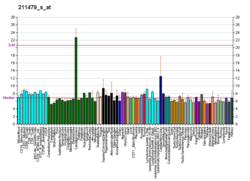Mice knock out and other studies have been used to determine which ADAR enzyme are involved in editing. Editing at A and B sites has been demonstrated to be due to ADAR1 editing. [50] [51] [52] Also since ADAR1 expression is increased in response to the presence of interferon α, it was also observed that editing at A and B sites was also increased because of this. [50] C' and D sites require ADAR2 and editing is decreased by the presence of ADAR1 with editing of C' site only observed in ADAR1 double knock out mice. [53] The C site has been shown to be mainly edited by ADAR2 but in presence of upregulated expression of ADAR1, there was an increase in editing of this site and the enzymes presence can also result in limited editing in ADAR 2 knock out mice. [50] [53] This demonstrates that there must be some form interaction between the two A to I editing enzymes. Also such interactions and tissue specific expression of ADARs interaction may explain the variety in editing patterns in different regions of the brain.
Consequences
Second, the editing pattern controls the amount of the 5-HT2CR mRNA that leads to the expression of full-length protein through the modulation of alternative splice site selection 76,77. Among three alternative splice donor sites (GU1 to GU3; Fig. 4C), GU2 is the only site that forms the mature mRNA to produce the functional, full-length 5-HT2CR protein. Unedited pre-mRNAs tend to be spliced at the GU1 site, resulting in the truncated, non-functional protein if translated 76,77. However, most pre-mRNAs edited at more than one position are spliced at GU2 77. Thus, when editing is inefficient, increased splicing at GU1 may act as a control mechanism to decrease biosynthesis of the 5-HT2CR-INI and thereby limit serotonin response. Third, RNA editing controls the ultimate physiological output of constitutively active receptors by affecting the cell surface expression of the 5-HT2CR. The 5-HT2CR-VGV, which displays the lowest level of constitutive activity, is fully expressed at the cell surface under basal conditions and is rapidly internalized in the presence of agonist 78; additionally, in vitro, LSD shows negligible activity with this isoform. [54] In contrast, the 5-HT2CR-INI is constitutively internalized and accumulates in endosomes 78.
Structure
As mentioned editing results in several codon changes. The editing sites are found in the second intracellular domain of the protein which is also the receptors G protein coupling domain. Therefore, editing of these sites can affect the affinity of the receptor for G protein binding. [44]
Function
Editing results in reduced affinity for specific G proteins which in turn affects internal signalling via second messengers (Phospholipase C signalling system). The fully edited isoform, VGV, considerably reduces 5-HT potency, G-protein coupling and agonist binding, compared to the unedited protein isoform, INI. 72–76. Most evidence for the effect of editing on function comes from downstream measurements of receptor activity, radio ligand binding and functional studies. Inhibitory effects are linked to the extent of editing. Those isoforms with a higher level of editing require higher levels of serotonin to activate the phospholipase c pathway. Unedited INI form has a greater tendency to isomerise to an active form which can more easily interact with G proteins. This indicates that RNA editing here may be a mechanism for regulating neuronal excitability by stabilising receptor signalling. [44] [48]
Editing is also thought to function in cell surface expression of the receptor subtype. The fully edited VGV, which has the lowest level of constitutive activity, is fully expressed at the cell surface while the non-edited INI is internalised and accumulates in endosome. [55]
Editing is also thought to influence splicing. Three different spliced isoforms of the receptor exist. Editing regulates the amount of 5HT2CR mRNA which leads to translation of the full length protein selection of alternative splice sites. t76,77. These splice sites are termed Gu1, Gu2, GU3. Only GU2 site splicing results in translation of the full length receptor while editing at GU1 is known to result in translation of a truncated protein. This is thought to be a regulatory mechanism to decrease the amount of unedited isoform INI to limit serotonin response when editing is inefficient. Most of the pre-mRNAs which are edited are spliced at the GU2 site. [46] [49]
Dysregulation
Serotonin family of receptors are often linked to pathology of several human mental conditions such as Schizophrenia, anxiety, Bipolar disorder and major depression. [56] There have been several experimental investigations into the effects of alternative editing patterns of the 5HT2CR and these conditions with a wide variability in results especially those relating to schizophrenia. [57] Some studies have noted that there is an increase in RNA editing at site A in depressed suicide victims. [12] [57] E site editing was observed to be increased in individuals with major depression. [58] In rat models this increase is also observed and can be reversed with fluoxetine with some suggestion that E site editing maybe linked to major depression. [59] [60]




